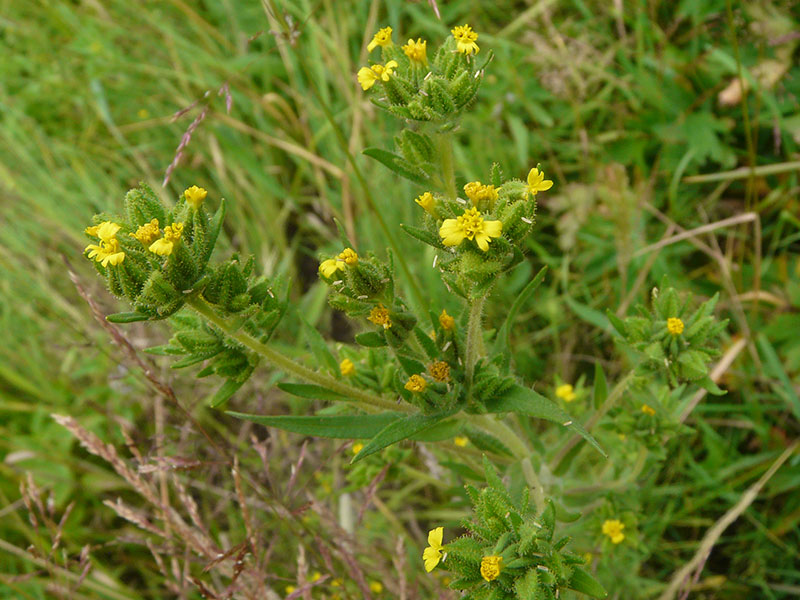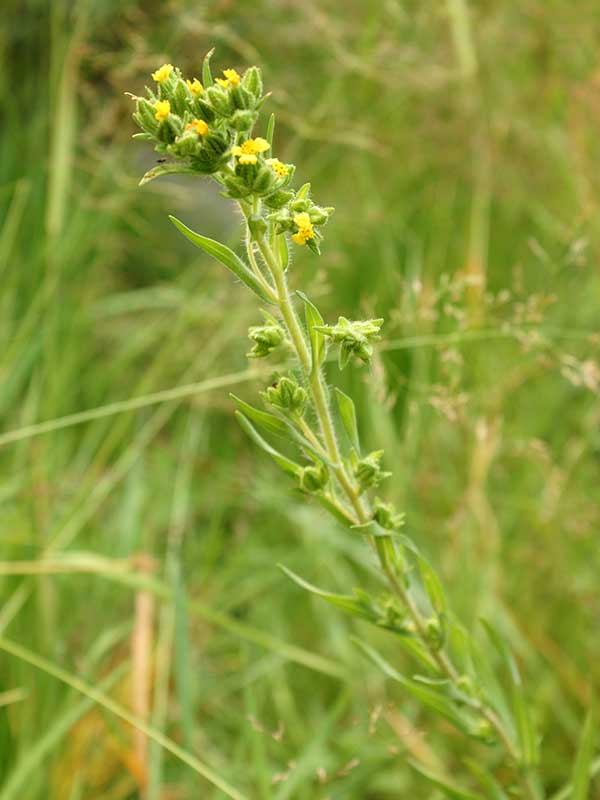Madia glomerata / mountain tarweed
- stems, leaves, flowers – strongly aromatic, like tar
- sticky glandular hairs cover foliage and floral bracts
- flowers in clusters with 1 to 3 yellow ray florets
- disk florets retain visible petals; black stamens
Also known as: cluster tarweed, stinking tarweed
Mountain tarweed is an aromatic annual, as much as 3 feet tall. The shoots are either simple or with stiff, vertical branches. The leaves are 1 to 4 inches long, alternately arranged, with dense hairs on the lower side and sparse glandular trichomes (hairs) on the top. The stems are also covered with the resinous, sticky trichomes. Indeed, sticky trichomes are the hallmark of this species.
Although aromatic, the “aroma” here is not one for perfume or potpourri, but instead, is rather tar-like (it varies between plants). On one website, it is described as so disgusting that the photographer didn’t want to get near enough for a picture. On another, it is noted that the tar is hard to get off dogs.
The inflorescence of mountain tarweed is a cluster of blossoms, each of which is surrounded and supported by bracts with copious glandular trichomes. Unlike other Madia spp., M. glomerata has only a few (0-3) yellow ray flowers and 1-5 disk flowers. The ray flower petals are lobed, but not as symmetrically as in other madias, and unlike most other members of the Asteraceae, the petals of the disk flowers are not completely fused into a tube but rather, maintain their petaly look. The disk florets are also notable for their black stamens.
Mountain tarweed grows mostly on disturbed sites including “openings” – in grasslands, in meadows, forests, on the edges of wetlands or ponds, and on paths or roadsides. The photos here are from Mahogany Creek Trail where the overall floral diversity was striking, but the plant was on the path edge, hence “disturbed”. Tarweed prefers full sun, but can tolerate light shade.
The “sticky” bits are good deterrents for insect would-be feeders… land here and you are stuck. In fact, the “carrion” of dead, small insects on the hairs may lead to a kind of secondary defense by larger predator insects who come to feed on the bodies. This results in decreased herbivory and increased plant fitness, i.e. more babies. (Here’s a journal article on that). And despite the stickiness, the flowers are insect pollinated.
| Color | |
|---|---|
| Family | |
| Blossom size | |
| Inflorescence size | |
| Inflorescence type | |
| When? | |
| Where? | disturbed, forest gaps and roadsides, grasslands, meadows, widespread |


